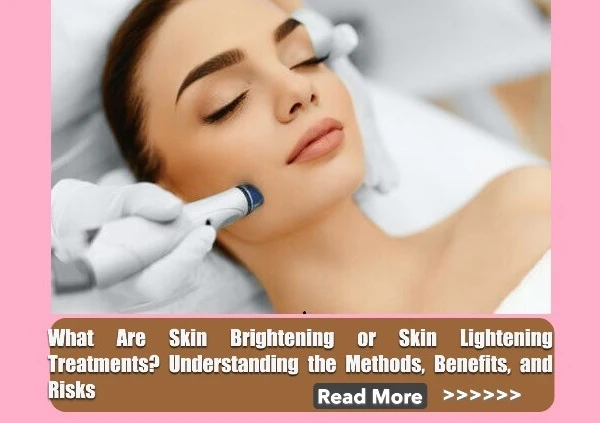What Are Skin Brightening or Skin Lightening Treatments? Understanding the Methods, Benefits, and Risks
What Are Skin Brightening or Skin Lightening Treatments? Understanding the Methods, Benefits, and Risks
Skin brightening and skin lightening treatments are commonly used to improve skin tone, reduce hyperpigmentation, and achieve a more even, radiant complexion. While these terms are often used interchangeably, they have slightly different goals and treatment approaches. Here's a comprehensive look at what these treatments involve, how they work, their benefits, and potential risks.
Skin Brightening vs. Skin Lightening: What's the Difference?
-
Skin Brightening:
This refers to treatments or products that enhance the skin's natural glow by removing dullness, dead skin cells, and promoting cell turnover. The goal is not to alter the skin’s natural color but to restore its clarity and radiance. -
Skin Lightening:
This involves reducing melanin production in certain areas to fade dark spots, age spots, acne scars, melasma, and other forms of hyperpigmentation. The aim is to even out the skin tone rather than lighten the entire complexion.
Common Skin Brightening and Lightening Treatments
-
Topical Creams and Serums:
-
Ingredients like Vitamin C, niacinamide, kojic acid, arbutin, and licorice root extract are widely used to brighten skin and reduce pigmentation.
-
Hydroquinone is a powerful skin lightening agent prescribed for stubborn dark spots but should be used under medical supervision.
-
-
Chemical Peels:
Mild acids like glycolic acid, lactic acid, or salicylic acid exfoliate the top layer of skin, reducing discoloration and dullness while encouraging new skin cell growth. -
Laser Treatments:
-
Fractional lasers, Q-switched lasers, and intense pulsed light (IPL) can target pigmentation, sunspots, and uneven skin tone.
-
These procedures offer quicker results but require multiple sessions and post-care.
-
-
Microdermabrasion and Dermabrasion:
These exfoliating techniques remove the outermost layer of dead skin, revealing brighter skin beneath and improving texture and tone. -
Glutathione Treatments:
Sometimes taken orally or through IV injections, glutathione is an antioxidant that may reduce melanin production. However, its safety and effectiveness for skin lightening are still debated.
Benefits of These Treatments
-
More even skin tone
-
Reduction in pigmentation, age spots, or acne scars
-
Brighter, glowing complexion
-
Improved texture and smoother skin surface
-
Boost in confidence and overall appearance
Potential Risks and Precautions
-
Skin Irritation or Sensitivity: Especially with acids and strong active ingredients.
-
Allergic Reactions: Some lightening agents can trigger inflammation or allergic responses.
-
Sun Sensitivity: Treated skin can become more vulnerable to UV damage.
-
Overuse Risks: Excessive use of lightening agents (e.g., hydroquinone or steroid creams) can cause long-term damage, including ochronosis (blue-black discoloration).
-
Uneven Results: Without proper application or care, pigmentation might worsen.
Conclusion
Skin brightening and lightening treatments offer effective solutions for addressing uneven skin tone and hyperpigmentation, but they must be chosen carefully based on skin type and needs. Consulting a dermatologist is essential to avoid risks and ensure safe, long-lasting results. Always follow a proper skincare routine, use sunscreen daily, and avoid unregulated or harsh bleaching products.

Related Blog
What Causes Oily Skin and Can It Be Managed Naturally? Exploring Root Causes and Gentle Solutions
Aug 2, 2025 by Admin
General
What Are the Signs That You Have Sensitive Skin? Key Symptoms to Help You Identify This Delicate Skin Type
Aug 1, 2025 by Admin
General